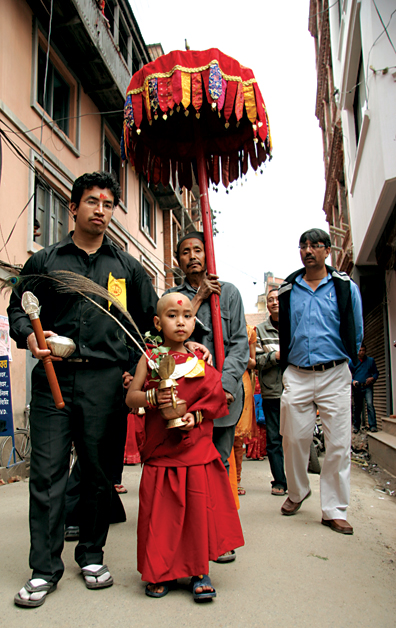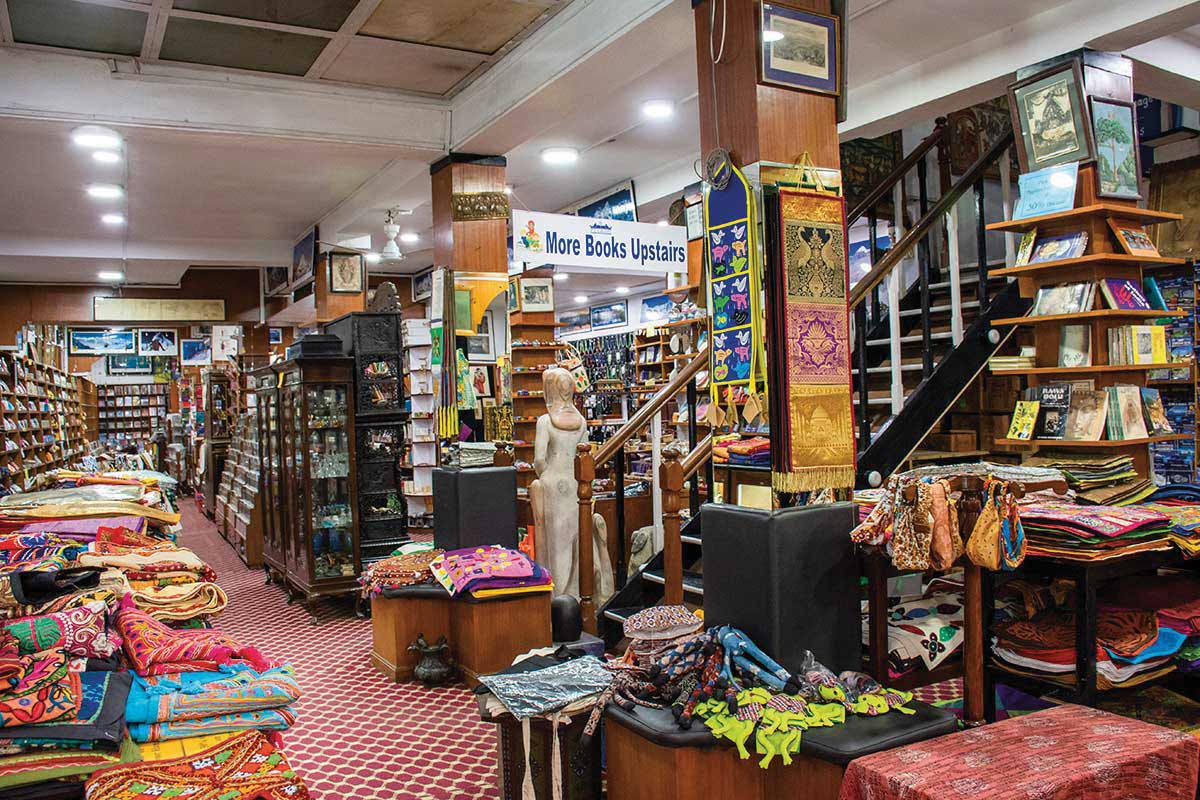As twenty six young monks lined up in front of the old Royal Palace in Basantapur Durbar
Square, cameras started clicking away from all directions. A group of elderly tourists, who happened to pass by while a Shakya/Bajracharya Bratabandha was underway, got more than their money’s worth by entering the square. Family members inched their way into the crowd as they tried to capture one of the most precious moments in their child’s life. Amidst the growing crowd, I found myself unable to find a good spot for a photograph of my kid brother in a yellow monk’s robe. So as a last resort, I raised my camera high, pointed it in his general direction and started clicking away.
 Every part of the Bratabandha is not as chaotic as this, though. Fortunately, the entire ceremony for a Shakya Bratabandha is managed by a sangha, a traditional committee formed for the preservation of local Newar traditions. There are a large number of sanghas in Newar communities, each being responsible for performing a defined set of duties. It is the work of the sangha, responsible for organizing the Bratabandha, to handle everything from all the puja ceremonies, the traditional music to be played, the feast for the aunts and maternal uncles on the final day to the gold that is gifted to the aunt of the young monk. The sangha responsible for organizing the Bratabandha collects an agreed amount of money prior to the ceremony to cover all necessary costs.
Every part of the Bratabandha is not as chaotic as this, though. Fortunately, the entire ceremony for a Shakya Bratabandha is managed by a sangha, a traditional committee formed for the preservation of local Newar traditions. There are a large number of sanghas in Newar communities, each being responsible for performing a defined set of duties. It is the work of the sangha, responsible for organizing the Bratabandha, to handle everything from all the puja ceremonies, the traditional music to be played, the feast for the aunts and maternal uncles on the final day to the gold that is gifted to the aunt of the young monk. The sangha responsible for organizing the Bratabandha collects an agreed amount of money prior to the ceremony to cover all necessary costs.
Managing the Bratabandha through such a committee makes sense economically, too, since arranging to have such a large service independently would cost a small fortune. For any given Bratabandha, the sangha picks a date for the ceremony and then notifies the community to submit the names of the children eligible that year. After collecting this information, the sangha decides on the various items to be used and their costs, and after discussions by representatives of all families of the community, decides upon a budget to be shared amongst all families taking part in the Bratabandha.
Next the sangha issues notices to all concerned families, which lists the step-by-step process to be followed on the five day program. The notice also mentions all conventions to be strictly
followed. From the color of the sari the boys’ aunts are to wear, to the program schedule; every little detail for the ceremonies are pre-planned.
The presence of a sangha that dates back several decades points clearly at the richness of Newar culture. It can be said without doubt that most festivals that are celebrated in the country with much pomp are of Newar origin, although people from all backgrounds take part in them enthusiastically. To have had the sense to divide the community’s work in sanghas says a lot about the managerial skills of the people.
Shakyas are a sub-caste of Buddhist Newars. They are believed to be direct descendants of Lord Buddha, since Buddha was a Shakya king from the Tarai town of Kapilvastu. It is due to this heritage that every Shakya boy is made to live the life of a monk for at least five days. These five days and the rites and rituals preceding and following it are known as a Bratabandha ceremony. Although other Newars also practice this tradition, their ceremony lasts only one day and is called ‘Keta Puja’. Also, while a Shakya Bratabandha is done in large groups, other Newars and Hindus may practice their rites
independently.
In our sangha, the age criterion for a boy to be eligible for Bratabandha is from five years upwards, with most Shakya families preferring to celebrate the occasion while their child is young. The first day of the Bratabandha, all of the young boys’ hair except for a few strands at the back is shaved off with a silver and gold blade. The aunts of the boys are made to receive the hair on a silver platter. A small piece of gold is attached to this strand of hair as they are taken along with all the other young boys who too are having their Bratabandh, to Hanuman Dhoka Durbar to offer Supari and Paan (beetle leaf) to Hindu deities. On the second day, the remaining hair is shaved off and the gold attached to the boys’ hair is gifted to their aunts for receiving their hair. On the same day the boys are made to change into a monk’s attire. From the second day onwards the boys must live off alms from relatives and even strangers. They may not eat salt for the entire duration of the ritual and must not take off the robe throughout
either.
On the last day maternal uncles of the boys guide them towards Hanuman Dhoka once again for the final rites. The boys’ shaved hair is then offered by their aunts at a holy confluence of two rivers as an apology to Lord Buddha for ceasing to live the life of a monk. The boys can then go back to living their normal lives. There are many who choose to not go back to their normal lives, but who go on to live in Buddhist monasteries. This, I suspect, might be one of the reasons why Newar families prefer the Bratabandha to be over at a young age so that the child will prefer to come back to family life.
One of the highlights of the Bratabandha ceremony is the traditional music played while the hairs of the young boys are being shaved. The melodies are traditional with the musicians who have inherited these playing duties from their elders. One of the rarities in the group of musicians playing in a Newar Bratabandha is that women are allowed to play instruments alongside the men. The sight of young Newar women playing traditional instruments alongside their male counterparts catches even the local people off-guard. The age old melodies fill the air with a clear vibrancy that does two things: summon the attention of good spirits towards this customary ceremony and generate a celebratory mood, as the procession slowly flies out to go around the neighborhood.
A Bratabandha is a milestone in the life of Newar men. It presents them with a choice very early on about the kind of life they wish to live. There are many instances where young boys have, to the dismay of their parents, opted to not come back to their families and have gone on to live in a Bihar (monastery). These kinds of incidents are few and far between today. Nevertheless, the strength of a family, in being willing to respect the wishes of a young boy speaks volumes about the uniquely charmed lifestyle of Newar Buddhists.









